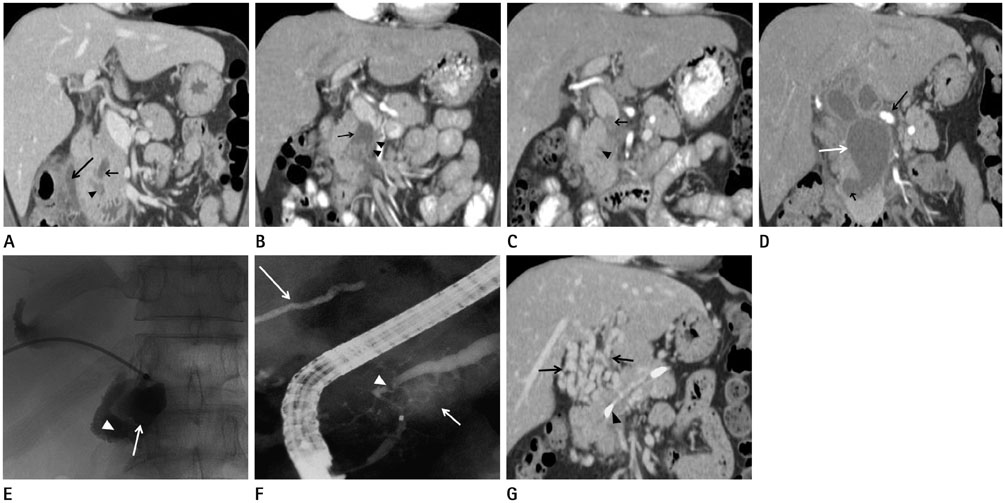J Korean Soc Radiol.
2015 Mar;72(3):180-184. 10.3348/jksr.2015.72.3.180.
Pancreatic Pseudocyst-Portal Vein Fistula: Serial Imaging and Clinical Follow-up from Pseudocyst to Fistula
- Affiliations
-
- 1Department of Radiology, Dankook University Hospital, Dankook University College of Medicine, Cheonan, Korea. jkn1303@dreamwiz.com
- KMID: 2161170
- DOI: http://doi.org/10.3348/jksr.2015.72.3.180
Abstract
- Pancreatic pseudocyst-portal vein fistula is an extremely rare complication of pancreatitis. Only 18 such cases have been previously reported in the medical literature. However, a serial process from pancreatic pseudocyst to fistula formation has not been described. The serial clinical and radiological findings in a 52-year-old chronic alcoholic male patient with fistula between pancreatic pseudocyst and main portal vein are presented.
MeSH Terms
Figure
Reference
-
1. Aghdassi A, Mayerle J, Kraft M, Sielenkämper AW, Heidecke CD, Lerch MM. Diagnosis and treatment of pancreatic pseudocysts in chronic pancreatitis. Pancreas. 2008; 36:105–112.2. Hammar AM, Sand J, Lumio J, Hirn M, Honkonen S, Tuominen L, et al. Pancreatic pseudocystportal vein fistula manifests as residivating oligoarthritis, subcutaneous, bursal and osseal necrosis: a case report and review of literature. Hepatogastroenterology. 2002; 49:273–278.3. Yamamoto T, Hayakawa K, Kawakami S, Nishimura K, Katsuma Y, Hayashi N, et al. Rupture of a pancreatic pseudocyst into the portal venous system. Abdom Imaging. 1999; 24:494–496.4. Bradley EL, Clements JL Jr, Gonzalez AC. The natural history of pancreatic pseudocysts: a unified concept of management. Am J Surg. 1979; 137:135–141.5. Kaman L, Behera A, Singh R, Katariya RN. Internal pancreatic fistulas with pancreatic ascites and pancreatic pleural effusions: recognition and management. ANZ J Surg. 2001; 71:221–225.6. Lee SH, Bodensteiner D, Eisman S, Dixon AY, McGregor DH. Chronic relapsing pancreatitis with pseudocyst erosion into the portal vein and disseminated fat necrosis. Am J Gastroenterol. 1985; 80:452–458.7. Skarsgard ED, Ellison E, Quenville N. Spontaneous rupture of a pancreatic pseudocyst into the portal vein. Can J Surg. 1995; 38:459–463.8. Van Steenbergen W, Ponette E. Pancreaticoportal fistula: a rare complication of chronic pancreatitis. Gastrointest Radiol. 1990; 15:299–300.9. Yoon SE, Lee YH, Yoon KH, Choi CS, Kim HC, Chae KM. Spontaneous pancreatic pseudocyst-portal vein fistula presenting with pancreatic ascites: strength of MR cholangiopancreatography. Br J Radiol. 2008; 81:e13–e16.10. Brown A, Malden E, Kugelmas M, Kortz E. Diagnosis of pancreatic duct-portal vein fistula; a case report and review of the literature. J Radiol Case Rep. 2014; 8:31–38.
- Full Text Links
- Actions
-
Cited
- CITED
-
- Close
- Share
- Similar articles
-
- Non-invasive MR Demonstration of the Fistula between Pancreatic Pseudocyst and Portal Vein: A Case Report
- Intrahepatic Bile Duct Dilatation Caused by Pancreatic Pseudocyst: A Case Report
- A Case of Cystoduodenal and Cystocolic Fistula Complicated in Pancreatic Pseudocyst
- Mediastinal pancreatic pseudocyst naturally drained by esophageal fistula
- A Gastric Hemorrhage through the Fistula between Stomach and Pancreatic Pseudocyst with Ruptured Splenic Artery Pseudoaneurysm : A Case Report


